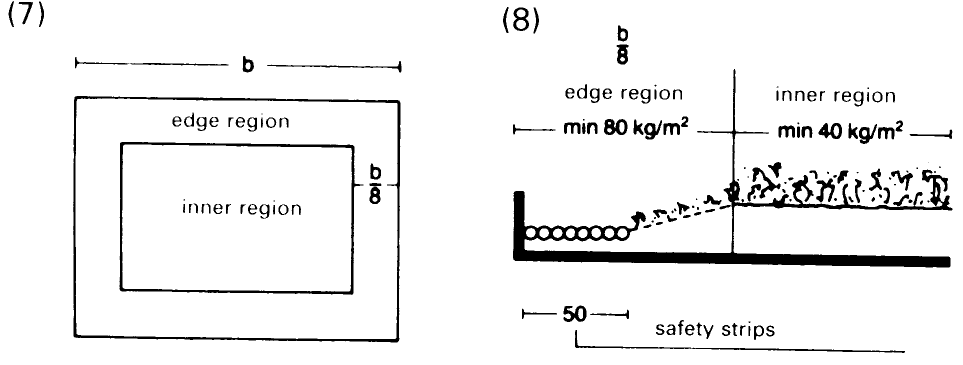Extract from Guidelines of the Roof Garden Association
Definitions. 1. Extensive roof cultivation implies a protective covering that needs upkeep, replacing the customary gravel covering. 2. To a large extent, the planted level is self-replenishing and the upkeep, i.e., maintenance, is reduced to a minimum.
Scope. These guidelines apply to areas of vegetation without natural connection to the ground, particularly on building roofs, and roofs of underground garages, shelters, or similar structures.
Principles of constructive planning and execution:
1. In extensive roof cultivation, the cultivated area acts as a protective covering - see the recommendations for flat roofs.
2. Roof construction and structure: the relevant structural and constructional principles of the building and its roof must be carefully interrelated with the technical requirements imposed by the vegetation and its supporting elements.
3. The surface loading required to secure the waterproof membrane is the minimum weight per unit area of the operative layers in accordance with the table below, taken from the Roof Garden Association recommendations for planting on the flat roofs.

5. The type of construction employed in the roof and the degree of surface loading are dependent on the wind loading, the height of the building and the surface area of the roof.
6. High suction loads can occur around the edges and corners of the roof over a width b/s > 1 m < 2 m.

9. Cultivated roofs should be designed to be easily maintained, i.e. areas which need regular attention (such as roof drainage inlets, structures which protrude from the cultivated area, expansion joints and wall junctions) should be easily accessible.
10. In these areas, the protective layer should comprise of inorganic materials such as shingle or loose stones.
11. These areas should be linked with the roof drainage inlets, so that any overflow from the planted areas can drain away.
12. Large surface areas should be subdivided into separate drainage zones.
Requirements, functions, constructive precautions:
1. The waterproofing membrane should be designed in accordance with the recommended specifications for flat roofs.
2. The development of the cultivated area should not impair the function of the roof waterproofing membrane.
3. It should be possible to separate the waterproofing layers from the cultivation layers, i.e. it must be possible to inspect the waterproof membrane of the roof.
4. The root protection layer must provide durable protection to the roof waterproofing layers.
5. High polymer waterproofing membranes should, because of their physical and chemical makeup, be able to satisfy the demands of the root protection layer.
6. If a bituminous roof waterproofing system is applied, then bitumen-compatible root protection layers should be employed.
7. The root protection layer should be protected from mechanical damage by a covering; non-rotting fibre mats should be used since these can store nutrients and additional water.
8. The vegetation layer must have a high structural stability and must exhibit good cushioning capability and resistance to rotting.
9. The pH value should not exceed 6.0 in the acidic range.
10. The construction of the layers must be capable of accepting a daily precipitation level of at least 30/m2.
11. There should be a volume of air of at least 20% in the layer structure in the water saturated condition.
Maintenance at the plant level:
1. Wild herbaceous plants and grasses from the dry grassland, steppe and rock crevice species should be used in the planted areas. All plants used should be perennial.
2. The plants used should be young plants, sown as seed or propagated by cuttings.
3. Maintenance: at least one routine per year, when the roof inlets, security strips, roof connections and terminations are inspected and cleaned as necessary.
4. Plants, mosses and lichen which settle are not considered as weeds.
5. All undesirable weeds should be removed.
6. Woody plants, in particular willow, birch, poplar, maple and the like, are considered to be weeds.
7. Regular mowing and fertilising should be carried out.
8. Changes at the plant level may occur through environmental effects.
Fire prevention:
1. All fire precaution recommendations should be observed.
2. The requirements are fulfilled if the flammability of the structure is classed as flame resistant (material classification B1).
Characteristics of a satisfactory roof cultivation.An extensive planted area has planting out, sowing, setting of cuttings, pre-cultivated plants (plant containers, mats and panels). The vegetation layer provides stability for the plants, contains water and nutrients and allows material and gas exchange and water retention. The vegetation layer must have a large pore volume for gas exchange and water retention. The filter layer prevents the flushing out of nutrients and small components of the vegetation layer and silting up of the drainage layer. It also ensures that water drains away gradually.
The drainage layer provides safe removal of overflow water, aeration of the vegetation layer, the storage and, if necessary, a water supply. Root protection protects the roof waterproofing membrane from chemical and mechanical contact with the roots of the plants which, in searching for water and nutrients, can be destructive. Roof construction must be durably waterproof, both on the surface and in all connections with other components. The formation of condensation water in the roof structure must be effectively and permanently prevented.
Date added: 2023-01-01; views: 607;
